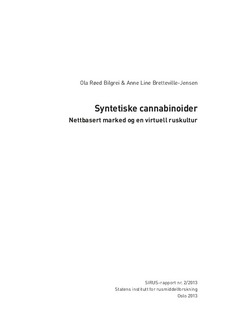| dc.contributor.author | Bilgrei, Ola Røed | |
| dc.contributor.author | Bretteville-Jensen, Anne Line | |
| dc.date.accessioned | 2015-01-30T14:22:47Z | |
| dc.date.accessioned | 2015-02-11T20:21:35Z | |
| dc.date.available | 2015-01-30T14:22:47Z | |
| dc.date.available | 2015-02-11T20:21:35Z | |
| dc.date.issued | 2013 | |
| dc.identifier.citation | SIRUS-rapport. 90 p. Statens institutt for rusmiddelforskning, 2013 | |
| dc.identifier.isbn | 978–82–7171–401–7 | |
| dc.identifier.uri | http://hdl.handle.net/11250/276076 | |
| dc.description | - | |
| dc.description.abstract | Syntetiske cannabinoider
n
ettba
S
ert marked og en virtuell ru
S
kultur
7
Oppsummering
•
Syntetiske cannabinoider er kjemiske stoffer som er laget for å etterligne
virkningen til organisk cannabis.
•
Stoffene ble først utviklet av legemiddelindustrien på 1980-tallet, men få av dem
ble satt i ordinær produksjon fordi det viste seg vanskelig å skille ønskede og
uønskede virkninger.
•
De ble først markedsført og solgt som «naturlige» og «lovlige» alternativer til
tradisjonelle cannabisprodukter (hasj og marihuana), i form av blandinger med
tørkede urter og planter.
•
Etter avsløringer som viste at disse blandingene inneholdt syntetiske cannabi
-
noider, selges det nå både i ren pulverform og sammen med tørkede plante- og
urteblandinger.
•
Første beslag i Norge ble gjort i 2009. I 2012 ble det gjort 262 beslag som samlet
ga 5,9 kilo av stoffene. Dette tilsvarer godt over en million brukerdoser.
•
En stor andel av beslagene gjøres utenfor det sentrale Østlandsområdet, og
stoffene er beslaglagt i alle landets fylker.
•
En befolkningsundersøkelse blant 16–30-åringer i Norge i 2012 (n=706) viste at
ca. 3 prosent av dem
som hadde brukt cannabis siste år
(n=67) også hadde brukt
syntetiske cannabinoider i løpet av de foregående 12 måneder. Blant alle spurte
var andelen 0,3 prosent.
•
Den internasjonale litteraturen på området er foreløpig relativt beskjeden. En
nylig publisert gjennomgang viste at det er få studier som omhandler omfang,
brukerkultur, motiver eller omsetning av syntetiske cannabinoider.
•
Ingrediensene for å lage syntetiske cannabinoider finnes til dels lovlig tilgjengelig
på verdensmarkedet. Kina er antatt hovedprodusent, mens India nevnes i økende
grad.
•
Ingrediensene settes sammen til ferdige stoffer både i Kina og i enkelte europeiske
land.
•
Selv om syntetiske cannabinoider nok til en viss grad omsettes via vennenettverk
og regulære narkotikahandlere, selges trolig det meste av disse stoffene via
internett
butikker med utenlandske nettadresser | |
| dc.description.abstract | Synthetic cannabinoids are chemicals that are designed to mimic the effects of organic cannabis.
• The substances were developed initially by the pharmaceutical industry in the 1980s, but few of them were put into regular production because it proved difficult to separate desired from undesired effects.
• They were initially marketed and sold as “natural” and “legal” alternatives to traditional cannabis products (hashish and marijuana). The cannabinoids were dissolved in a solvent and clandestinely sprayed onto dried herbs and plants for delivery.
• When it was revealed that the herbal mixtures contained synthetic cannabinoids, these research chemicals were put on the market in their own right. Thus, synthetic cannabinoids are now sold as two different products; powder and herbal mixtures.
• The first seizure in Norway happened in 2009. There were 262 seizures in 2012, amounting all to 5.9 kilos, or well over a million user doses.
• A large proportion of the seizures are made outside Oslo and Eastern Norway, and drugs have been seized in every county in the country.
• A survey of 16–30 year olds in Norway in 2012 (n=706) revealed that about 3 per cent of those who had used cannabis in the last year (n=67) had used synthetic cannabinoids in the preceding 12 months as well. That percentage with regard to all respondents was 0.3.
• The international literature on this subject is relatively sparse. A recent literature review found only a small number of studies addressing issues such as incidence, user culture, motivation or trade in synthetic cannabinoids.
• The ingredients needed to make synthetic cannabinoids can sometimes be found legally on the global market. China is considered the main producer, though India is increasingly mentioned.
• The ingredients are mixed together and fashioned into ready-to-use drugs in China and certain European countries.
• Although synthetic cannabinoids are sold via networks of friends and acquaintances, and ordinary drug dealers, most of them are probably bought at online outlets with foreign URLs. | |
| dc.language.iso | nob | |
| dc.relation.uri | http://www.sirus.no/filestore/Import_vedlegg/Vedlegg_publikasjon/sirusrap.2.13.pdf | |
| dc.title | Syntetiske cannabinoider. Nettbasert marked og en virtuell ruskultur | |
| dc.title.alternative | Synthetic cannabinoids. Online market and a virtual drug culture | |
| dc.type | Research report | |
| dc.date.updated | 2015-01-30T14:22:47Z | |
| dc.identifier.cristin | 1067932 | |
